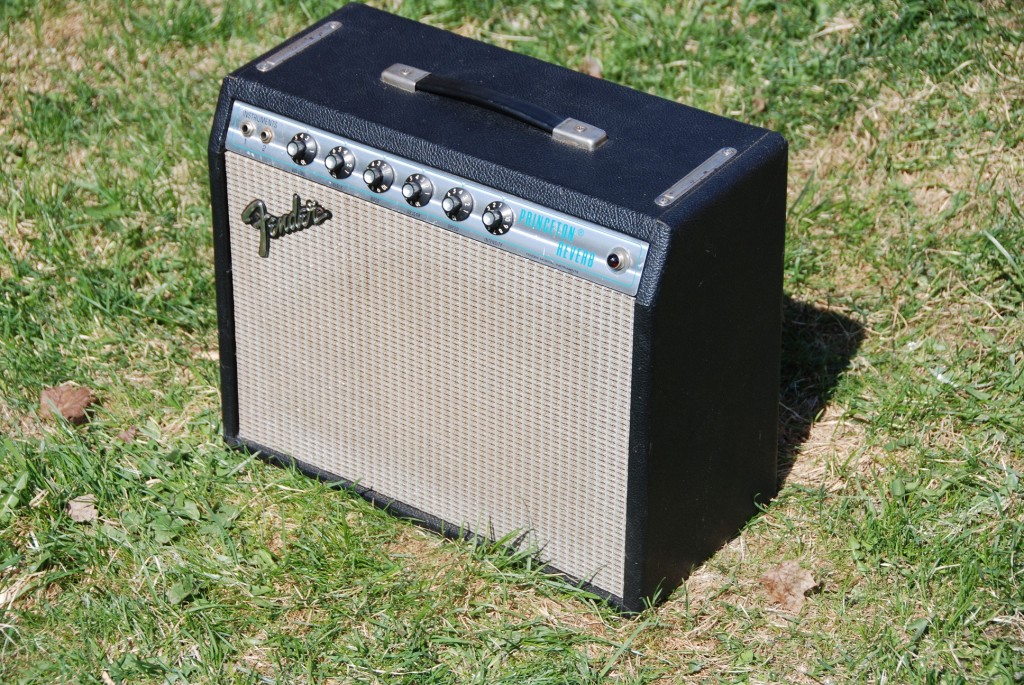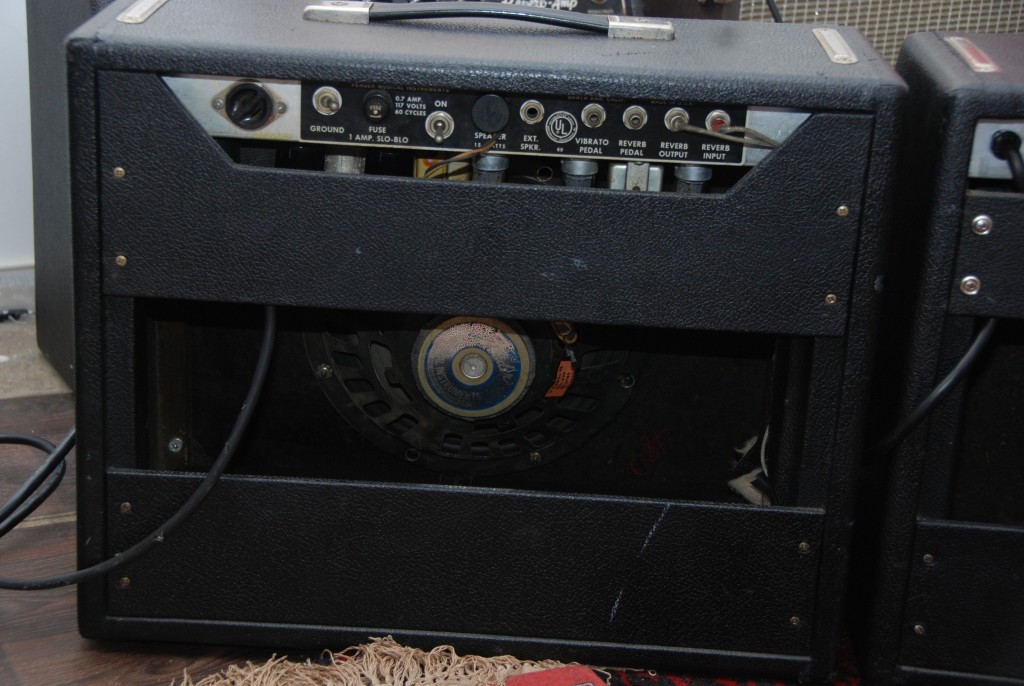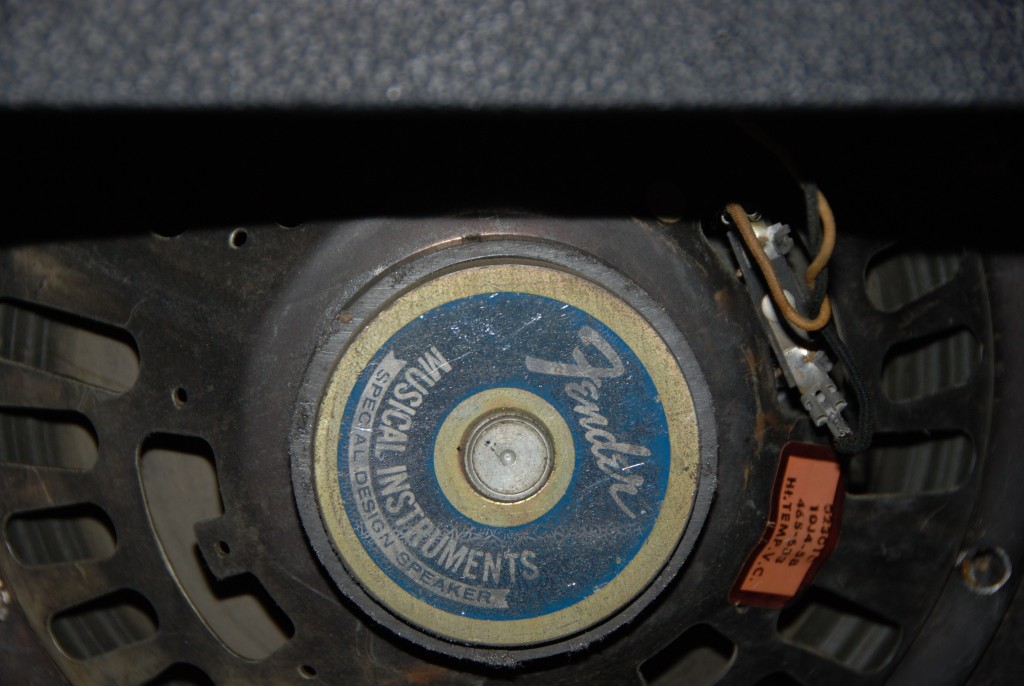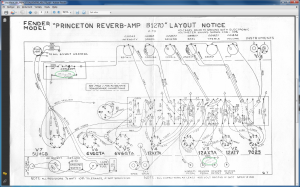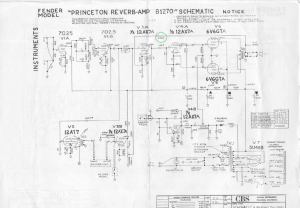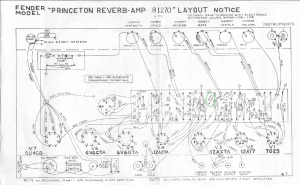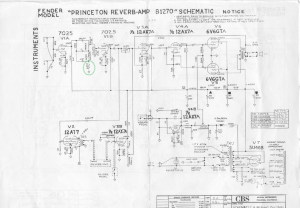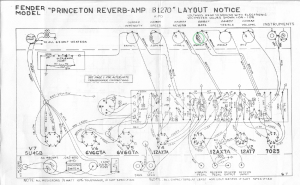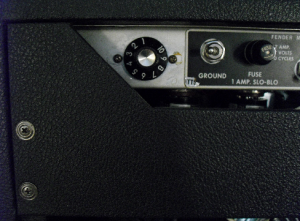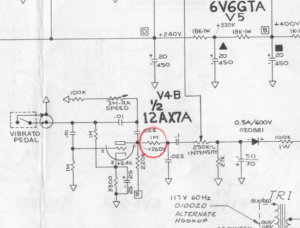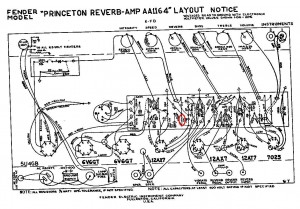Production years:
- 1964 -1967 “blackface” circuits AA1164 (pre-CBS), AB1270 (CBS) and AA764 (CBS)
- 1968-1978 “silverface” circuit AB1270 without Push-pull.
- 1978-1981 “silverface” circuit with Push-pull volume boost.
Tube layout and tube replacements
AA1164 Tube layout (Seen from behind, V1 is to the right side)
V1 12ax7 = Preamp
V2 12at7 = Reverb send
V3 12ax7 = 1/2 Reverb recovery and 1/2 Reverb mix
V4 12ax7 = 1/2 Vibrato and 1/2 Phase inverter
V5 6V6 = Power tube #1
V6 6V6 = Power tube #2
V7 5U4GB = Rectifier tube
Summary
The Princeton Reverb is the smallest blackface/silverface Fender amp with both tremolo and reverb. With a 10 inch speaker run by a 12-15W dual 6V6 amp, it delivers a true “American” Fender tone with punchy, responsive lows together with chimey highs. When it is cranked it tends to sound a bit “browner” than the bigger two-channel amps, meaning more breakup in the lower frequencies and mid-focused tone. Much of this is due to an unefficient phase inverter circuit design.
Compared to many bigger Fender amps the Princeton Reverb (PR) wenr through the CBS/silverface periods with very little changes. The rectifier tube was one of the tube and circuit changes where the 5U4GB was replaced by a GZ34. In build quality and component selection (brands of caps, resistors, pots) the silverfaces are not as robust as the blackface models. The glued and stapled baffles on the silverface amps is to us one of the bigger differences between the blackface and silverface amps, or should we say, the cabinets. Still, many people consider the tone of the silverface Princeton Reverb just as good as the blackface. Being almost a blackface amp with a “wrong” faceplate, the large number of silverface models became popular player’s amps. Lot of value-for-the-money. As a player’s amp one could replace the speaker with a bigger one without “ruining” the value of it, like for the precious collectable blackfaces. First in 1978, when the push/pull volume boost was introduced, there was a significant difference from the traditional blackface circuit.
So, why would you want to enhance or mod a PR? Due to its small size many players want to increase the power, volume and clean headroom. A few also wants to change the distortion characteristics. We’ve seen no other amp that has been analyzed so thoroughly in terms of mods and tricks to make it bigger. Does this mean you should implement the mods too? Not necessarily. Just because many people does so, it doesn’t mean it’s right for you.
In general we don’t recommend the mods that increase the power and clean headroom unless you actually have experienced the amp to be too small at gigs. If you are using your amp at home or in recording situations you should appreciate the early breakup of the original 6V6 power tube circuitry, the ineffective phase inverter, a smaller output transformer and a low-medium inefficient 10″ speaker. You are lucky to have a tube amp that breaks up nicely and shines at you every day at practise volumes. It’s what everybody really wants. So why increase the threashold of tube heaven?
If you’re micing the amp the audience should have no problem hearing a stock PR (we know: it can be hard to trust the sound engineers). Your job is to make sure your band and yourself can hear the amp on stage. If you need a bigger amp on stage, go ahead reading below.
You’ll need schematics to implement some of these mods. http://www.ampwares.com/fender.asp. We usually start with explaining a mod from a functional perspective where we relate to components in the logical schematics diagram. Finally we point out location of components in the physical layout diagram.
Speaker
The easiest and most effective mod of them all. The speaker is the most important component in your amp which physically produces the air waves that your ears detect as a tone. Originally the Princeton Reverb came with Jensen C10N, C10r, Oxford 10L5 or Oxford 10J4. The picture belows shows an Oxford 10j4 in a 66 blackface model. The Oxford speakers are known as relative inefficient speakers (not loud) with moderate bass response. They’re not as punchy as the Jensens, CTS and Utah speakers from the time, not to mention the modern speakers of today’s world who are much louder. Having that said, tone is not about volume. The Oxford speakers are Fender correct and will give you decent cranked tones at moderate volumes. We think the Oxfords are underestimated.
Among the original speakers in the blackface and silverface amps we personally favor the vintage Jensen C10n speakers due to the huge clean tone and big bottom end caused by the large magnet and 1,5″ voice coil. The picture below shows a vintage 1966 Jensen C10n.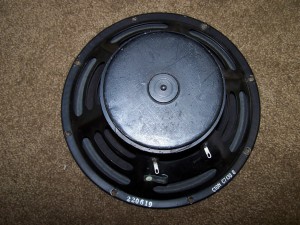
This speaker matches the amp and cabinet size perfectly and you get a classic, scooped fender blackface tone from a little amp. The vintage Jensen C10n Princeton Reverbs are rare and during the silverface era most Princeton Reverbs were equipped with the Oxford speakers. If you have one of these you’ll experience a significant change (to the better, in many’s opinion) by swapping to almost any other speaker. By most guitarists the Oxfords are considered weak and they fart out in the lows when being pushed hard. Because of the low efficiency you’ll have to turn up the amp and push the tubes harder to get any volume. The Oxfords have gotten a bad rumor, not rightfully deserved in our opinion. Players who play clean will experience a well balanced and “vintage fender correct” clean tone. They’re not too loud and nor do they bother you with a shrill brightness. They do have some vintage vibes and a nice musical voice. Inefficient speakers can be useful in multiple speaker applications 2-4 x10″ where the total areal of speakers will provide enough volume for you anyway. Anyway, you need to try for yourself and see if you prefer an oxford speaker in the PR or if you need more volume and punch.
Personally we mostly play our Princeton Reverbs at volume 5-6 with a decent amount of tube amp distortion (caused by preamp, power amp, transformers, rectifier all together). The amp delivers a thick sustaining tone where single notes are clean and chords are crunhcy. A distorted signal will have higher harmonic frequencies that may come out sharp and brittle through bright and sparkling speakers. Since we mostly play our PR with distortion we like darker sounding speakers. There are speakers like the Eminence Ramrod that Excels with screaming, distorting amps. The Jensen C10n and Weber 10A125, among others, excel in their clean tone but will also reveal a lot of the higher frequencies. You have to know how to tame this by EQ’ing your amp and selecting the right pedals and guitar. See page How to select speakers for speaker recommendations.
The video below shows three Princeton Reverbs with Oxford 10j4, Jensen C10n and Eminence Ramrod.
The video below shows a Princeton Reverb with a Weber 10A150, a very punchy and massive speaker with huge low mids and bass. Listen to the blond Baja Tele and the ES335. The red Tele is played through a Deluxe Reverb.
12″ speaker upgrade
You can either replace the original 10″ baffle with a 12″ baffle, or you can drill new holes in the existing baffle. Don’t mind if the baffle hole is tailored for a 10″. If you have seen or played a few vintage amps from the 50’s and 60’s, you’ll know that there doesn’t need to be a nice circular cut hole that matches the speaker perfectly.
A 12″ speaker will push more air and give you a bigger sound with more low ends, particularly more lower mids. A 12″ can normally handle more power than a 10″ at both lower and higher frequencies. The 12″ speaker is slightly harder to drive and if you’re really into a soft touch and finger tips you’ll probably appreciate the dynamics of a 10″ more than with a 12″. An interesting effect with 12″ speakers is the “3D” sound effect. While 10″ speakers can be front directional (depending on cabinet also) there is a better spread with 12″ speakers which contributes to a better sound on stage. People will hear you better wherever they are positioned relatively to the amp. A 15″ speaker has even more spread and it will cut through skin and bone. We have never heard anyone who upgraded to a 12″ go back to 10″. Maybe that will tell you something.
If you have a large speaker chassis be careful so that it will fit under the outpout tranformer. If you cut a new baffle your self (out of a particle board plate), you might want to align the speaker vertically as low as possible. Try to dry fit the speaker with the amp chassis and cabinet loose before you drill the screw holes.
12AY7 or 12AT7 as preamp tube – Less preamp gain.
If you want a cleaner and spankier tone you can replace the V1/V2 12AX7 preamp tube with 12AT7 or 12AY7. These tubes have lower voltage gain and different frequency responses, particurlarly when distorting. 12AX7 tube has a voltage gain factor = 100, while 12AT7 = 60 and 12AY7 = 45. One could describe these tubes to have less harsh and buzzy distortion. This mod does not alter the tone significantly when amp is played clean’ish. You’ll have to increase the volume setting to achieve a similar volume as before. If you hit sweet spot at volume=4 with 12AX7 you may go as high as 6-7 before reaching it with 12AT7 or 12AY7.
Replace the 12AT7 reverb driver with 12AU7 – Better reverb control.
Reverb is an important character with vintage amps, yet so individual and mysterious. We all know that speakers change their tonal character during age. So does the reverb. The reverb function sounds and behaves differently between “identical” vintage amps. Some amps have long, lush and soft reverb while others are mushy and overwhelming. We often find the reverb sweet spot around 2.5 on the reverb pot, varying from 2 to 4. Some amps are sensitive and difficult to control the reverb on. The whole dynamic area can be within a narrow interval, i.e. 2 and 2.5. These amps require a careful touch when dialling in the reverb, which irritates us.
The reverb circuitry consists of two tube sections (reverb driver V3 and reverb recovery V4) and the physical reverb tank. All these components will drift during age and minor differences in component values are noticeable to man’s ear.
If you replace the V3 12AT7 reverb driver with a 12AU7, you will reduce the effect of the reverb and it will be much easier to control with the reverb knob. So simple as that.
Diode rectifier – More clean headroom.
This mod is for those who wants more power, clean headroom and attack. It is very practical to bring with you those small Sovtek plastic adapters that easily can replace the rectifier tube (either the 5U4 or GZ34). You’ll increase the power of the amp with a few watts. The diode rectifier will feed your amp’s filter caps with a higher and “faster” DC voltage compared to a tube rectifier. The fact that it delivers a slightly higher DC voltage to your power tubes (via the filter caps) means an increase of the tube voltage gain factor. When you hit a hard chord the preamp and power tubes will require energy and current is flowing from the DC filter caps which are charged up by the rectifier. If the recitifer can deliver more energy more quickly, you’ll have more power and attack.
Please be aware of that using gz34 or diode rectifier will wear you 6v6 power tubes faster than with a 5u4gb due to the higher plate voltage. Some 6V6 tubes are better than others in handling higher voltages. The TAD and JJs are rough and can take a lot of beating.
Check also out Ted Weber’s “Copper Cap Rectifiers” that emulates the sag of a tube rectifier.
Blackfacing
It takes very little effort to blackface the silverface PR models without the push-pull volume boost. If you have a blackface PR you should inspect the circuit and not just the tube chart to verify which model you have, either the AA1164, AA764 or AB1270. Sharp readers will see that the silverface AB1270 circuit is identical to the blackface AB1270. Otherwise, there are minor differences within all blackface and silverface circuits.
To our knowledge, the following changes were introduced in AB1270 and AA764 (compared to the pre-CBS AA1164):
- The 5U4 rectifier tube was changed to a GZ34 in AA764. GZ34 has noticably less sag than a 5U4. So if you want the sag (compression effect) of a pre-CBS blackface PR, go down to 5U4.
- The electrolytic cap providing dc voltage to tremolo circuit changed from 25?F/50V to 50?F/70V in AB1270 and 50?F/70V in AA764.
- The reverb recovery circuit in AB1270 got a 2000pF highpass cap leading higher frequencies to ground. This makes the reverb slightly darker with less presence, if noticable at all. See the green circled cap to the left.
Click the images for full size versions.
Negative feedback loop
The negative feedback loop can easily be tweaked to alter the treble cut and distortion in your amp. The purpose of the NBF loop is to clean up the tone and cancel out the mid/higher frequencies and upper harmonics (distortion) at the entry point of the phase inverter which is placed in front of the power tubes. The NBF theory is that you take the signal from the speaker output, let it go through a resistor and mix it in at the entry point of the phase inverter. The speaker signal is out of phase (180 degrees) with the signal at the entry point of the phase inverter and will cancel out equal frequencies. If you disconnect the NBF loop you’ll notice that the volume increases and tone gets much more aggressive. More white noise too. unfortunately, which is why there is a NFB loop. You will fin the amp’s sweet spot at a lower volume knob setting without the NFB loop. Not only is there a volume shift, the amp’s clean headroom is reduced slightly. Most importantly the tone gets rougher and rawer with more mids and higher frequencies, aka presence. If you think your tone is too bright or harsh or you’re seeking a mellow and nice clean tone, you probably want to keep the NBF loop. This mod is for those who want more bite and a tone that really cuts through in the mix.
You may choose to implement the mod in several ways and in various combinations with the ground switch or a foot pedal. A foot pedal works like a boost/FAT pedal. If yo’re struggling to find a transparent boost pedal that keeps the natural Fender tone you should try this out. You will still have that beautiful Fender tone, just more and wilder.
- No negative feedback at all. Simply disconnect the feedback loop (a wire) and tape insulate it. You get the most effect of this mod by disconnecting the NFB loop entirely. You may experience that the tone gets harsh, depending on guitar, speakers and EQ settings of course. If so, read more about the cap in the next bullet point.
- Keep the feedback loop and install a .01 µF in series with the NBF resistor. This cap will prevent the lower and mid frequencies to go through the NFB loop. Depending on the cap value treble frequencies will be fed back to the phase inverter which cancels out the treble in the main path. The tone gets less harsh and you still have a noticeable effect. You should experiment with different cap values. Start with 0.01µF.
- Increase the feedback loop resistance value. A good starting point is twice the original resistor value. This reduces the effect of the feedback loop, making the amp break up more when the NFB is engaged. If you make the NBF switchable there will be less volume difference if you use a high resistor value. (Using a .01 µF cap is also recommended to minimize the difference a little bit between NBF on and off).
- Use the ground switch or foot pedal to make the NBF switchable. If you remove the death cap and free up the ground switch by removing existing wires to it (if you’re wondering what the ground switch does, you don’t need it). Then wire the ground switch in series with the NBF resistor. If you’re using a cap in the NBF loop this goes across the switch allowing treble to bypass independent of the switch. When the ground switch has disconnected the NBF loop the higher frequencies are still fed back through the cap. In practice you solder each the two cap legs to at each side of the switch between speaker terminal and NFB resistor.
Where to install footpedal or switch? The ground switch is easy available if you disable the power supply wires and death cap. For amps with reverb you could use the reverb footswitch phono plug if you are not using it.
Bigger output transformer – More power.
Simply replace the output transformer (OT) with a Deluxe Reverb OT. This reduces the output transformer sag and limitation that the Princeton is known for. With a bigger transformer you will experience more attack and a bigger sound due to more efficient power transformation from your tubes. You should consider this mod if you are increasing the headroom in your amp (Paul C mod, Stokes mod, Diode rectifier, etc ). In this case the original OT is not able to deliver this power to the speaker without absorbing some energy and introducing sag and too much compression.
Output transformer with multiple impedances (built-in attenuator)
This mod requires the knowledge of how to replace a transformer in your amp. This mod will give you different speaker outputs impedances converting the the external speaker jack to an independent output.
The original OT is sized for an 8 Ohm speaker impedance. It will make sure the power tubes “see” the correct impedance and can operate at optimal conditions in terms of clean headroom potential and frequency response. If you had an OT designed for a 2 ohm speaker load the tubes would operate at their best with a 2 ohm speaker load. If you use a 8 ohm speaker with a 2 ohm OT, the tubes are pushed harder since they see a bigger load than expected. Both volume and clean headroom is reduced significantly, and the tone is not significantly changed. This effect is similar to an attenuator, which is very nice when you want to achieve the amp’s sweet spot at lower volumes.
- Go to Mercury Magnetics web site. Order the Deluxe Reverb multi-tap OT with 2, 4 and 8 ohm taps. Yes, we mean the Deluxe Reverb OT.
- Remove the original OT carefully in your Princeton Reverb and store it away. Install the Mercury Magnetics OT.
- Wire the OT’s primary circuit just as before. Clip the cables nicely and twist them as Leo Fender’s gently old ladies did.
- The OT’s secondary circuit will be wired differently. Wire the 8 ohm tap to the main speaker jack. Then wire the 2 (or 4 ohm) tap to the ext speaker jack. You must first remove all existing wires to the external speaker jack so that it is totally separated from the main speaker jack.
- Now you have two speaker outputs; 8 and 2 ohms (or 4 ohm). You may use them independently and the ext speaker jack does not require the main speaker jack plugged to work.
We like this mod a lot. Especially since we’re using the original jack outputs. Choosing the 2 ohm output with a 8 ohm speaker will attenuate the volume a lot. Having an amp with several different output impedances is practical for those who are using extension cabinets.
Middle pot
The PR did unfortunatley come without a mid pot. Many players are happy with the default 6.8K mid resistor in the EQ circuitry, but some want what the others have; a 10K potmeter mounted in series with the 6.8 Kohm resistor. When the potmeter is set at 0 you’ll have an original tone, and when turned up the mids increases and your amp growls with a British Vox’ish tone (especially together with a Celestion speaker). For a wider tone range you can replace the 6.8 KOhm resistor with a 4 KOhm, and use the 10 K pot to go beyond the original 6.8 KOhm and up to 14 KOhm. If you do not use the reverb or tremolo pedal it is very practical to install the middle pot here. It requires a simple solder and removal job to replace the phono plugs with a mid pot. Or you could install the mid pot at the left most side of back of the amp where the additional power supply is located.
Layout
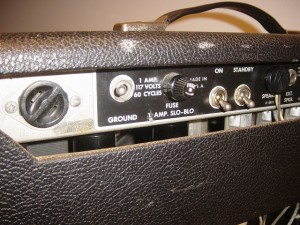
Weak tremolo
Some Princeton Reverbs have weak tremolo. This can sometimes be solved by changing the vibrato tube V4 12AX7 or even the power tubes. If this does not help one can change a resistor value to increase the strength of the tremolo. See figures below which resistor this is. Replace the 1 MOhm resister attached to pin 1 of the V4 tube with a lower value. One can use 500K or even lower, 270K.
Logical schematics
Layout
The Stokes mod – increases voltage to the phase inverter
This mod, and the Paul C mod, is so thoroughly discussed elsewhere that we will only make a few comments on it. It will give your amp more headroom meaning you can play cleaner at a louder volume. Otherwise the tone of the amp stays much the same. You should also replace the output transformer with a larger one to cope. Here is one reference http://www.blueguitar.org/new/articles/blue_gtr/amps/john_paul_rick_PRmods.pdf.
The Paul C mod – convert PI to fixed bias
This mod will give you smoother distorition characteristiscs and a fuller sound. If you think your amp and speaker are sharp and edgy this mod could be worth a try. It will not increase the power and clean headroom. The mod requires some rewiring with a soldering iron and a new resistor. For description and schematics take a look here http://www.blueguitar.org/new/articles/blue_gtr/amps/john_paul_rick_PRmods.pdf.
Bass and tone characteristics.
The following mods are for those who want to change the tone in terms of more or less bass. To tighten up bass means removing the farty, low bass frequencies which are not handled well in a low power amp like the PR. These mods should be considered together with the particular speaker and effect pedals you are using to suit your music style. We do not say these mods should be implemented by everyone, we just inform you that there are techniques to shape your tone to suit your musical expression.
- Reduce input-stage cathode from 25 to 4.7 to “tighten up” bass.
- Increase 1st filter cap to 40uF (increase low end).
- Reduce coupling cap that feeds PI, also a means to “tighten up” the bass.


